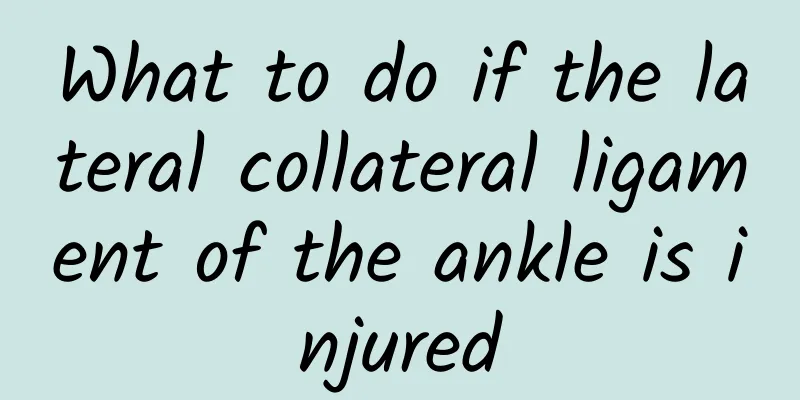What to do if the lateral collateral ligament of the ankle is injured

|
Injury to the lateral collateral ligament of the ankle joint is a relatively serious disease. It is caused by improper exercise, excessive exercise, or trauma. Sometimes it can cause the ligament to tear, causing severe pain, and leading to symptoms such as redness and swelling in the ankle joint. When this happens, you should go to the hospital for regular treatment in time and strengthen care in daily life. What to do if the lateral collateral ligament of the ankle is injured Anterior talofibular ligament injury: When the ankle joint is in plantar flexion and subjected to inversion stress, the anterior talofibular ligament is injured first. If it is completely ruptured, the anterior drawer test will be positive. Under forward stress, lateral X-ray images of the ankle joint may show slight forward displacement of the talus and subluxation. If it is a simple anterior talofibular ligament injury, the foot can be everted, the ankle can be dorsiflexed, and an 8-shaped bandage can be used for pressure immobilization, or it can be fixed with adhesive ointment and removed after 2 to 3 weeks. Calcaneofibular ligament rupture: If the inversion force continues to act after the anterior talofibular ligament is injured, the talofibular ligament may rupture. The anterior drawer test for peroneal calcaneal ligament injury was significantly positive, and the stress lateral X-ray image showed that the talus was significantly subluxated anteriorly. The anteroposterior X-ray image under varus stress shows that the talus body tilts within the ankle fossa, with the lateral side lowered and the medial side raised. Acute injury of the fibular calcaneal ligament requires early diagnosis and should not be missed to avoid ankle instability in the future due to failure to provide timely and appropriate treatment in the early stages. Acute complete rupture of the fibular calcaneal ligament can be repaired surgically. If it is an avulsion fracture of the apex of the lateral malleolus, the ankle joint can be placed in the 0° position and fixed in the eversion position with a short leg cast or U-shaped cast for 4 to 6 weeks. Surgery can also be performed, in which absorbable sutures are inserted through the proximal hole of the fracture and sutured to the proximal fracture fragment of the ligament. If the avulsed fracture fragment is large, it can be fixed with small screws, or with Kirschner wires and steel nails as a tension band. After surgery, it should be supplemented with plaster external fixation for 3 to 4 weeks [2]. Lateral ankle ligament reconstruction:If lateral ankle ligament injury is not treated promptly and appropriately in the early stage, persistent ankle joint functional instability may occur in the late stage. The indications for lateral ankle ligament reconstruction are: positive anterior drawer test and positive inversion stress test; conservative treatments such as muscle strength training, braces and orthopedic shoes are ineffective; symptoms persist and the patient requires surgery. Reconstructive surgery is divided into non-enhanced reconstructive surgery and enhanced reconstructive surgery. Non-reinforced reconstructive surgical methods include tightening the stretched ligament and fixing it through a bone hole, and suturing the distal fibula periosteal flap to the ligament surface. Its advantages are restoring the normal anatomical relationship and preserving the activity of the subtalar joint, and avoiding the use of the peroneal tendon to affect the weakening of the eversion muscle strength. Its disadvantage is that it is difficult to achieve stability in the reconstruction of weak local soft tissue. Therefore, it is not suitable for overly loose joints, injuries with a history of more than 10 years or longer, and cases with previous ligament repair surgery. The augmented reconstruction method refers to reconstruction by tendon transposition, and its result mainly depends on whether the selected transposed tendon and the position of the transposed tendon are appropriate and accurate. Generally, the peroneus brevis tendon is used for transposition, and the methods include right Evana, Watson-Jones, Chriaman-Smook, etc. The Anderson method uses the plantaris tendon for reconstruction. |
<<: What to do with ankle gout
>>: Varicose veins in the ankle
Recommend
Hypothalamic Pituitary Ovarian Axis
The hypothalamic-pituitary-ovarian axis is a rela...
Symptoms of turbid amniotic fluid in pregnant women
In the late pregnancy, the amniotic fluid becomes...
Before cancer came, this part of my body would itch unbearably
Everyone has experienced "itching". Som...
What is the best sleeping position for pregnant women in the fourth month? What is the effect on the fetus?
Generally speaking, the adjustment and arrangemen...
How to take care of nasal polyps on a daily basis
When it comes to general human diseases, what we ...
What are the symptoms of intermittent amnesia?
In real life, intermittent amnesia is a relativel...
What is the reason for large ejaculation volume?
Generally speaking, if there is a lot of semen du...
What are the effects of licorice?
In daily life, we often hear about a kind of lico...
Precautions for chronic bronchitis
In daily life, some of us have weak constitutions...
The efficacy and function of Yangteng root
Yangteng is a perennial woody plant that is droug...
What should I do if I have congenital gastrointestinal problems?
The stomach and intestines play a very important ...
High-risk behaviors for HIV infection
AIDS is a relatively serious disease in today'...
What is the difference between tuberous sclerosis and white spots
Many people may not know much about tuberous scle...
Causes of rheumatism
Rheumatism is a joint disease that can affect peo...
What is the effect of Luo Han Guo in treating chronic pharyngitis?
Chronic pharyngitis is a common laryngeal disease...









